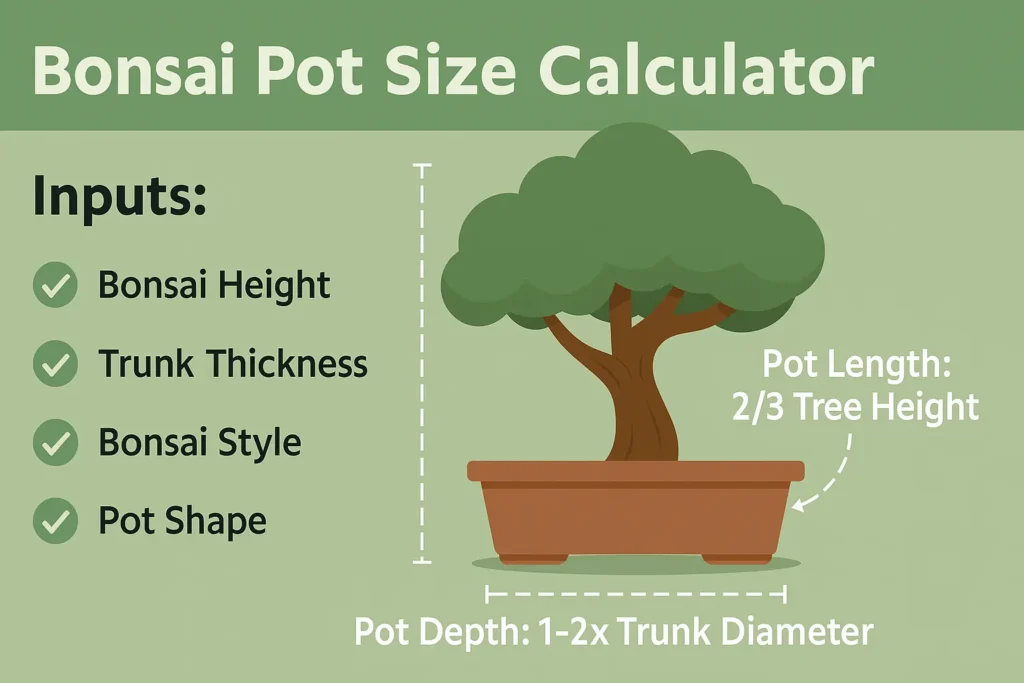Bonsai Pot Size Calculator
Bonsai Details
Bonsai Species
Bonsai Style
Disclaimer: This calculator is approximate. Always observe your tree’s root system, style needs, and overall health before choosing a pot.
Bonsai Pot Size Calculator

Created by James S. Lockwood
With a background in botany and ecological sciences, James specializes in creating practical tools and resources to help gardeners, farmers, and plant enthusiasts optimize their green spaces.
Table of Contents

Why Use Bonsai Pot Size Calculator?
Our Bonsai Pot Size Calculator provides a rough guideline for choosing an appropriately sized pot based on your bonsai’s:
- Height
- Trunk diameter
- Species (deciduous, conifer, or tropical)
- Styling (formal upright, informal upright, cascade, semi-cascade, windswept, etc.)
By entering these details, you’ll receive suggested measurements—both length/diameter and depth—to help you pick a pot that suits your tree’s needs and aesthetic.
Why Pot Size Matters
A bonsai’s pot directly affects:
Root Health – Too small and the roots may become overly constrained; too large and you might dilute the classic bonsai aesthetic and risk waterlogging.
Styling – Different bonsai styles (like cascade vs. upright) traditionally use different pot shapes and depths.
Tree Vitality – Certain species (e.g., tropicals) often do better with slightly deeper pots to maintain consistent moisture, while others (like conifers) can thrive in shallower pots.
How to Use the Bonsai Pot Size Calculator?
- Measure Your Bonsai:
- Height: From soil level to the apex.
- Trunk Diameter: At or near the base, above the root flare.
- Select the Species:
- Deciduous (e.g., Maple, Elm)
- Conifer (e.g., Pine, Juniper)
- Tropical (e.g., Ficus, Jade)
- Choose the Style:
- Formal Upright
- Informal Upright
- Cascade
- Semi-Cascade
- Windswept
- (Or whatever applies to your bonsai’s shape)
- Click “Calculate” to see recommended length (or diameter) and depth in inches.
- Optional:
- Click “Share Result” to send or save your pot size recommendations.
- Click “Clear All” to reset the fields and try another entry.
Important Notes
- Guidelines, Not Rules: Bonsai pot sizing is partly traditional (e.g., 2/3 the tree’s height for formal upright), but there’s artistic flexibility.
- Root Health & Pruning: A healthy root system can sometimes handle smaller pots, especially if you’re skilled with root pruning.
- Observe & Adjust: If your tree shows signs of stress (overcrowded roots, difficulty holding moisture, etc.), you may need to repot into a different size.
- Species Variations: Some trees—like fast-growing tropicals—may need more frequent repotting or a slightly deeper container.
Example Uses
- Planning a New Bonsai: After initial styling, you might use this calculator to pick your first “show pot.”
- Repotting Time: If you notice your bonsai’s roots circling or it’s been a while since you repotted, the calculator can guide you to an appropriate new size.
- Experimenting with Styles: Changing from an upright to a semi-cascade style? The pot depth and shape requirements differ. Use the calculator to see how much smaller or deeper the pot might get.
FAQs
1. How to choose pot size for bonsai?
Choosing the right pot size for a bonsai is about balancing aesthetics with root health. As a general rule:
Length of the pot should be about 2/3 the height of the tree (or 2/3 the width for a wide bonsai like a cascade).
Width should allow for visual breathing room but not overwhelm the tree’s canopy.
Depth depends on trunk thickness. A basic rule is:
🔹 Depth ≈ trunk diameter at soil level
For example, a tree with a 2-inch thick trunk should go in a pot roughly 2 inches deep.
This ensures the tree remains visually balanced while accommodating healthy root growth.
2. What is the rule of 3 in Bonsai trees?
The “rule of 3” in bonsai refers to visual composition and is rooted in traditional Japanese aesthetics:
1/3: The trunk (base to first branch)
1/3: The branch structure
1/3: The apex or top of the tree
This rule creates a proportionally pleasing shape that looks natural and timeless. It also relates to the golden triangle principle, where the first, second, and back branches form a visual triangle to guide the eye.
3. How do you calculate the size of a plant pot?
To calculate the appropriate size of a plant pot (for bonsai or otherwise), consider these steps:
Measure root spread and trunk base.
Choose a length that’s 2/3 the height or canopy width.
Set depth close to the trunk’s base diameter.
Allow a small buffer (~10–15%) for soil and root expansion but avoid oversized pots—especially for bonsai, where tight root space is intentional.
For regular potted plants, root depth and drainage needs dominate, but for bonsai, form and restraint take priority.
4. Should bonsai pots be deep or shallow?
Bonsai pots are traditionally shallow, and there’s a good reason for that:
Shallow pots help restrict root growth, which is essential to maintaining bonsai size.
They also expose more surface roots (nebari), which adds to the visual maturity and character.
Deeper pots are only used temporarily for recovery or very young trees needing strong root development.
So, unless you’re nursing a sick or untrained bonsai, shallow is not just preferred—it’s essential.
Disclaimer
Like any online tool, the Bonsai Pot Size Calculator:
- Is approximate.
- Doesn’t account for individual root structure, watering habits, soil composition, local climate, or personal aesthetics.
- Should be used alongside expert advice—consult experienced bonsai growers or reference specialized bonsai literature for detailed guidance.
